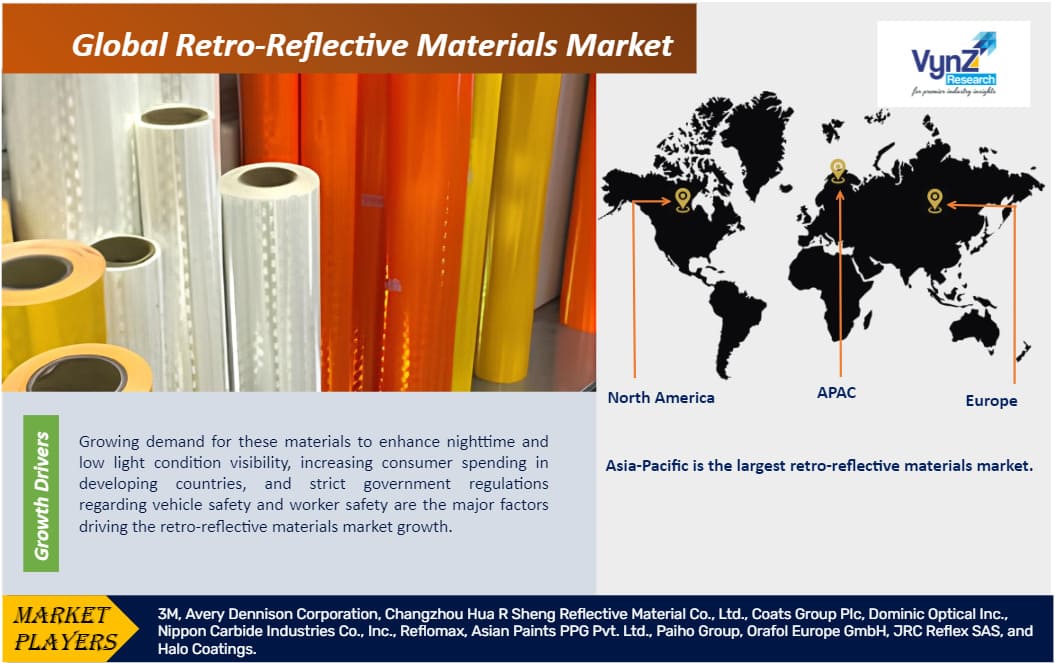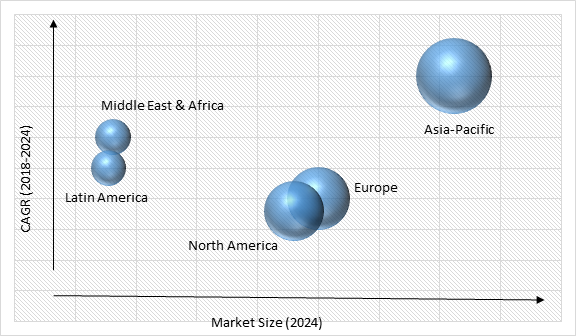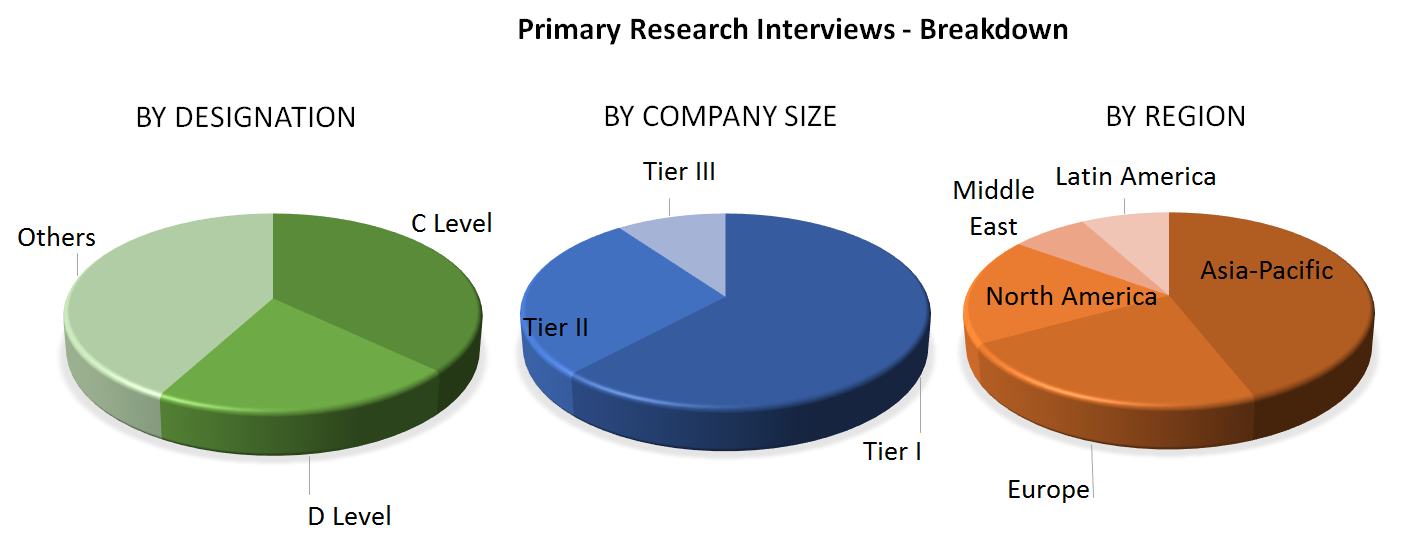Global Retro-Reflective Materials Market – Analysis and Forecast (2026-2035)
Industry Insights by Technology (Microprismatic, Glass Beads, and Ceramic Beads), by Product Type (Films, Sheets & Tapes, Paints, Inks & Coatings, and Others), by Application (Traffic Control & Work Zone, Conspicuity, Fleet & Vehicle Registration, Personal Safety, and Others) and Geography (U.S., Canada, Germany, U.K., France, China, Japan, India, and Rest of the World)
| Status : Published | Published On : May, 2025 | Report Code : VRCH2045 | Industry : Chemicals & Materials | Available Format :

|
Page : 147 |
Global Retro-Reflective Materials Market – Analysis and Forecast (2026-2035)
Industry Insights by Technology (Microprismatic, Glass Beads, and Ceramic Beads), by Product Type (Films, Sheets & Tapes, Paints, Inks & Coatings, and Others), by Application (Traffic Control & Work Zone, Conspicuity, Fleet & Vehicle Registration, Personal Safety, and Others) and Geography (U.S., Canada, Germany, U.K., France, China, Japan, India, and Rest of the World)
Industry Overview
The global retro-reflective materials market was projected to reach USD 14.0 billion by 2035, at a CAGR of 19.0% during the forecast period 2026-2035. The global retro-reflective materials market is projected to witness significant growth in the coming years owing to the stringent government regulations regarding worker and vehicle safety. These materials are used to increase the nighttime conspicuity of traffic signs, high-visibility clothing, and other items. In the light of an approaching vehicle, this makes them safe and effectively visible. Also, they are primarily used as a material to increase the barcode scanning range in factory settings.

Retro-Reflective Materials Market Segmentation
Insight by Technology
On the basis of technology, the market is classified into micro prismatic, glass beads and ceramic beads. The microprismatic segment is anticipated to register the highest growth in the retro-reflective materials market during the forecast period. Microprism enables minimum scattering of light while also ensuring maximum reflection of the light back to its source. The top growth is also attributed to manufacturers' high focus on providing products with a better retro-reflective property.
Insight by Product Type
Based on product type, the retro-reflective materials market is categorized into films, sheets & tapes, paints, inks & coatings, and others. The films, sheets, and tapes segment is projected to lead the market in the coming years, owing to their wide range of applications in different industries such as construction and infrastructure, apparel, automotive and transportation, and others.
Insight by Application
On the basis of application, the retro-reflective materials market is categorized into traffic and work zones, conspicuity, fleet and vehicle registration, personal safety, and others. Among all these, the traffic control and work zone category is anticipated to register the highest growth in the market during the forecast period. This is attributed to the increasing use of these materials in construction activities, as these materials are used on roadways, highways, warning signboards, guidance signboards, information signboards, and others. Along with that, these materials are also used for work zone products which include barricades, cones, drums, and various others.
Retro-Reflective Materials Market Report Coverage
|
Report Metric |
Details |
|
Historical Period |
2018–2023 |
|
Base Year Considered |
2024 |
|
Forecast Period |
2025 - 2030 |
|
Market Size in 2023 |
$xx.xx Billion |
|
Revenue Forecast in 2030 |
$14.0 Billion |
|
Growth Rate |
CAGR 19.0% |
|
Segments Covered in the Report |
By Technology, By Application, and By Product Type |
|
Report Scope |
Market Trends, Drivers, and Restraints; Revenue Estimation and Forecast; Segmentation Analysis; Impact of COVID-19; Companies’ Strategic Developments; Market Share Analysis of Key Players; Company Profiling |
|
Regions Covered in the Report |
North America, Europe, Asia-Pacific, Middle East, and Rest of the World |
Industry Dynamics
Retro-Reflective Materials Market Growth Drivers
Growing demand for these materials to enhance nighttime and low light condition visibility, increasing consumer spending in developing countries, and strict government regulations regarding vehicle safety and worker safety are the major factors driving the retro-reflective materials market growth. These materials are generally used on road signs and also on pavements, where the level of reflectivity must meet established standards. For instance, according to European Union standards, pavement markings should be visible to the average motorist which provide them a minimum of 2.5 seconds of reaction time after dark. Also, the choice of road sign colors is also guided by reflectivity concerns, for example, red and yellow colors are used more frequently, as they attract attention sooner as compared to other hues.
Retro-Reflective Materials Market Challenges
Low awareness of safety products in developing economies, limited shelf-life of retro-reflective products, and high manufacturing cost are among the major challenges identified in the retro-reflective materials market. Despite the numerous efforts by the governments of various countries, awareness regarding safety products is relatively low in developing countries such as India, China, and others, which is a major challenge hindering the growth of the market.
Retro-Reflective Materials Market Industry Ecosystem
The retro-reflective materials market is highly fragmented and the dominant players are using different strategies that include expansions, product launches, agreements, joint ventures, mergers and acquisitions, and others to increase their presence in this market.
Retro-Reflective Materials Market Geographic Overview
Globally, Asia-Pacific is the largest retro-reflective materials market, owing to the expansion of various industries in the region including construction and infrastructure, automotive and transportation, and others. Due to the rise in construction projects to meet the infrastructure demand of the growing population, the Asia-Pacific region is anticipated to witness the fastest growth in the market.
GLOBAL RETRO-REFLECTIVE MATERIALS MARKET, BY REGION (2024)

Retro-Reflective Materials Market Competitive Insight
Avery Dennison Corporation is a multinational manufacturer and distributor of pressure-sensitive adhesive materials, apparel branding labels and tags, RFID inlays, and specialty medical products. The company is a member of the Fortune 500 and is headquartered in Mentor, Ohio.
Changzhou Hua R Sheng Reflective Material Co., Ltd. is a professional enterprise engaged in design, production, and sales of reflective materials.
Some of the key players operating in the retro-reflective materials industry are 3M, Avery Dennison Corporation, Changzhou Hua R Sheng Reflective Material Co., Ltd., Coats Group Plc, Dominic Optical Inc., Nippon Carbide Industries Co., Inc., Reflomax, Asian Paints PPG Pvt. Ltd., Paiho Group, Orafol Europe GmbH, JRC Reflex SAS, and Halo Coatings.
Recent Developments by Key Players
Avery Dennison Corporation has gained acknowledgement from the Association of Plastic Recyclers (APR) for improving PET by cleanly removing labels during recycling and enabling HDPE mono-material recycling without interference. Company has achieved a new milestone with its CleanFlake technology, by introducing a repositioning feature.
Coats Group Plc and Brillo (a leading digital transformation services and solutions provider) collaborated to drive better business outcomes and increase customer satisfaction. Coats is the world’s largest thread and structural components manufacturer for apparel, footwear, and performance materials.
The Retro-Reflective Materials Market report offers a comprehensive market segmentation analysis along with an estimation for the forecast period 2026–2035.
Segments Covered in the Report
- Technology
- Microprismatic Technology
- Glass Beads Technology
- Ceramic Beads Technology
- Application
- Traffic Control & Work Zone
- Conspicuity
- Fleet & Vehicle Registration
- Personal Safety
- Others (Marine, Photosensors, Machinery)
- Product
- Films, Sheets & Tapes
- Paints, Inks & Coatings
- Others
Region Covered in the Report
- North America
- U.S.
- Canada
- Mexico
- Europe
- Germany
- U.K.
- France
- Italy
- Spain
- Russia
- Rest of Europe
- Asia-Pacific (APAC)
- China
- Japan
- India
- South Korea
- Rest of Asia-Pacific
- Rest of the World
- Middle East and Africa (MEA)
- South America

Frequently Asked Questions
Purchase Options
Latest Report
Research Methodology
- Desk Research / Pilot Interviews
- Build Market Size Model
- Research and Analysis
- Final Deliverabvle
Connect With Our Sales Team
- Toll-Free: 1 888 253 3960
- Phone: +91 9960 288 381
- Email: enquiry@vynzresearch.com
Retro-Reflective Materials Market
